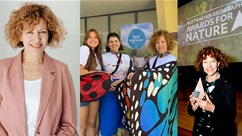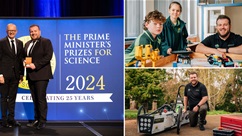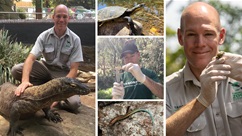KZ: Hi Stephanie! Congratulations on receiving a 2023 Australian Academy of Science Aboriginal and Torres Strait Islander Scientist Award! Why did you choose to research this topic?
S: Thank you! I am very excited about this opportunity. As an artist I love making natural dyes, I have been using this dye making process in my artmaking for a long time, it’s a way I connect to Country and better understand the natural world around me – for example what plants are found at different times of the year and how the season affects the colour of the dye. Natural dyes can be made by boiling leaves in water and adding fabric. You can get a large variety of different colours from natural dyes; this depends on the species of plant. My favourite to work with is Eucalyptus since you can get colours ranging from green, yellow, and brown to bright red. So this research came from my curiosity to understand where the colour comes from in the natural dyes I use to make art.
KZ: Are you currently researching or working on a new project?
S: I am constantly creating and chipping away at smaller projects that are interrelated to my overall larger goals of finding the connections between Indigenous science, visual arts, and chemistry. Although I am doing this for my PhD and in my teaching, this is an ongoing project that is a career-long goal. Art and science are very important to each other, when they are combined this enhances communication, creativity, and the depth of knowledge we can find in research. Right now, my focus is yarning with artists about how their knowledge can enhance the way we can understand the colour chemistry of natural dyes in the lab and how chemistry can increase artistic knowledge of natural dyes.
KZ: What has been the personal highlight of your career so far?
S: Every time I get the chance to curate an exhibition! I have curated four shows now, each exhibition combines everything I have been doing across art and science through Indigenous perspectives. It is always a wonderful opportunity to communicate to the world what I am doing through the voices of other artists who contribute their artworks and perspectives in each exhibition.
KZ: Can you share an interesting fact about your job?
S: I am very lucky in my job that I get a lot of creative freedom to design my research and the structure of the subject I teach. A way that I make my research and teaching content more meaningful and driven by cultural values, is to include as many First Nations perspectives as possible. In my teaching, this includes organising lots of guest lectures by Indigenous Australians who love sharing their culture and, in my research, I am doing this through yarning with other Indigenous artists and knowledge holders so my chemistry research can be achieved in the right cultural ways.
KZ: Did you take part in any activities as a child that gave you skills you use at work?
S: I had so many hobbies as a child - I think everything that you do throughout your life shapes you and gives you skills you use for whatever life path you choose. My childhood hobbies included:
- Learning to play music, I learned the piano all through primary and high school as well as ukulele and double bass in high school. I have read that reading music forms neural connections in the brain, so this skill made me better able to creatively solve problems.
- Reading widely! Fiction can teach very valuable life lessons, but also reading about science, technology, history, and art helps you understand the world and your place in it a lot better.
- Making anything and everything no matter how weird it turned out. I was always making art by painting and making sculptures using clay, textiles, and anything I found outside. This was where my artmaking skills developed and my creativity for using a wide range of materials in what I make.
- Going to art exhibitions and reading the labels next to the artworks helped me better understand what inspired me as an artist and researcher.
- Singing lessons and performing in school plays helped me to learn how to hold my body on stage and learning how to use my voice and breath has made me a better and more engaging teacher and public speaker.
- Writing, filming, and editing short movies, where my cousin and I played every part including the voiceovers for our toys who were characters in the story! Using creativity in any way that brings you joy makes you a more creative person.
KZ: What would you say to K-Zoners who want to work in a similar role?
S: If you find your passion you can make it happen, be patient and find creative ways to share what you love with the world. The more you create, the more creative you will be. Creating doesn’t just mean making art, it means coming up with exciting ideas and doing your best to make those ideas come to life. So, just keep analysing, investigating, and exploring things that make your heart happy!
Want to read more of our interview with Stephanie? Grab the May 2023 ‘Block Busters’ issue of K-Zone, out now!










Comment Now!